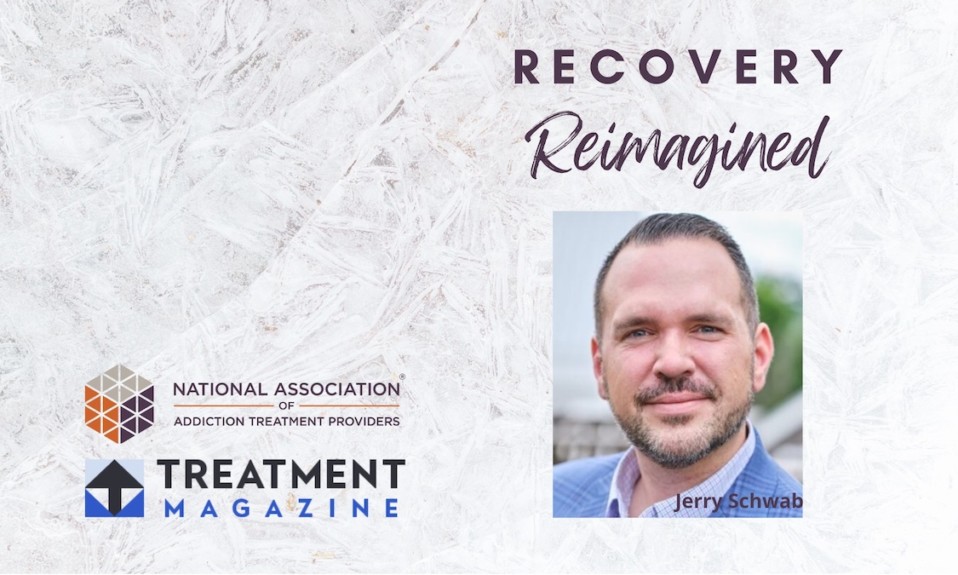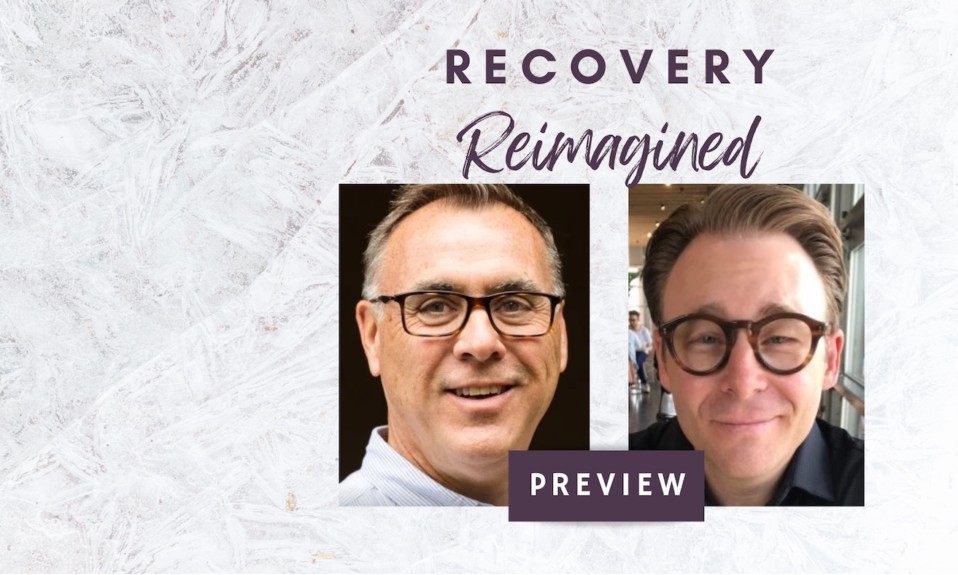The CEO of historic High Watch Recovery Center covers topics ranging from parity to the evolution of the addiction treatment space
Editor’s note: Jerry Schwab is CEO of High Watch Recovery Center, which has been in existence since the late 1930s and is located in Kent, Conn. Schwab has decades of experience as an executive with nonprofit healthcare organizations. This interview was conducted by Annie Peters, PhD, LP, who is director of research and education for the National Association of Addiction Treatment Providers (NAATP). It’s the latest installment in the Recovery Reimagined series, a collaboration between TreatmentMagazine.com and the NAATP that examines pressing issues in addiction and mental health treatment through conversations with esteemed people in the space.
By Annie Peters, PhD, LP
ANNIE PETERS: I’m really excited for this discussion about reimagining recovery, Jerry. First of all, could you just tell us a little bit about the history of High Watch and what you do there?
JERRY SCHWAB: High Watch Recovery Center is the oldest 12-step-based substance use treatment center in the country. We were founded in the fall of 1939 by Marty Mann and Bill Wilson, some of the founders of Alcoholics Anonymous, and we’ve been evolving and providing substance use treatment ever since.
AP: That’s a long time. But isn’t High Watch the oldest treatment center in the world?
JS: I didn’t want to brag, so I figured I’d stick to country. But, yes, we would be the oldest substance use treatment center in the world.
AP: That’s exactly the reason why I thought we should talk to you. I’m very curious, considering the history of High Watch, what would you say needs to be reimagined in the field of treatment and recovery from substance use disorders?
JS: High Watch has evolved over time. We are evolving quickly now, in the last couple of years, trying to update our programs and provide people with the best services. We try to help people be successful and have a long, happy, wonderful life that’s free from substances. Historically, with addiction treatment in the country, you look at the person while they’re in your care. They’re here with us for a period of time, and then they go, and it’s, “Let’s hope for the best.” Things have evolved a bit over time, with trying to be a little more targeted in getting people into outpatient programs and supportive care, but it’s very self-directed when they leave.
Addiction is a disease that speaks to you in your own voice. Sometimes you need a little bit more than just some phone numbers and some referral sources to follow up on your own. You really need to take somebody by the hand and have them be taken care of and supported and a bit managed through the process. What we’re trying to do here at High Watch is create sober communities, places where people could be with us under our umbrella, under our care, under our support for long periods of time—12 months, 24 months. People can be active parts of the community but also have the supports that they need to be successful.
“To reimagine what addiction treatment looks like, we need to do a better job of looking at a whole person. What is going on with the person that has created this situation?”
—Jerry Schwab
We’ve been studying people that come through our program here for a long time. If you look at the people that have done very well, they’ve stayed here for a long period of time or been under our care for 12 months. Addiction is a brain disease, and it takes a long time for the brain to be able to heal, for those impulse centers of the brain to be able to get under control.
To reimagine what addiction treatment looks like, we need to do a better job of looking at a whole person. What is going on with the person that has created this situation? From an addiction perspective, was it the chicken or the egg? What in their environment, in their childhood, is the root cause of the addiction or of the condition that they’re suffering from?
Sometimes with these people, they could be suffering from a co-occurring disorder [for which] they’re medicating with substances. Substances might not necessarily be the root underlying cause—it might be masking something else. We are seeing tons of young adults—late teens, early 20s—coming through with cannabis use disorder that appears to be masking some sort of psychiatric condition that they’re self-medicating. So first of all, it’s getting to the root cause of what’s going on with the individual and trying to address that. Is there a medical condition, an underlying psychiatric condition? What’s their environment, like at home? Then [it is a matter of] actually treating those.
An insurance company doesn’t say, “You have a very unhealthy, toxic home life that you’re living in, which is significantly contributing to your substance use. Let us try to help you get out of that.” It doesn’t go that way. They want you stabilized in residential treatment and then push you out the door as fast as they can [into] in an outpatient program. You’re going right back into the same environment, that same toxicity and toxic relationships. Then everybody is surprised in a month or two months or three months when the individual relapses. Treatment “failed,” but treatment really didn’t fail. We failed the person. I’m sure you’ve seen many situations where you’re in a treatment center and the patient goes out the door. You know they’re going right back into the environment they were in before, and the chances of success are very, very low. Yet we all act surprised when the person didn’t make it. The average person doesn’t have $50,000 or $60,000 a month to be in one of these safe environments and be taken care of.
AP: What are some of the more promising changes or shifts you have seen in recent years?
JS: From an initiative perspective, the idea of [parity] is right and sound, [but] the application or enforcement of it has been nil. It’s going to be a process that is probably going to require some judication to make sure that these things are enforced. Addiction needs to be treated like any other disease from an insurance company’s perspective, but even broader-based because there is a social component with regard to environment. [Parity is] looked at here and there and threatened and considered, but as the law is written, it is not enforced as it should be.
AP: Let’s say parity were enforced. What might that look like? What could it look like if we were addressing substance use disorders the same way we’re addressing other chronic medical illnesses?
JS: I don’t think that’s going to solve everything. The clinician or the provider, who knows the person and sees them every day, needs to be the decision-maker on what services somebody is going to get—not somebody sitting in an office of an insurance company, often not even in the same state, reviewing these cases. Having said that, I’d be a liar if I said there weren’t bad actors in the world. There needs to be a balance to it. The insurance companies can’t be expected to write blank checks, but I do think there are a lot of economies of scale. If you look at what is spent on a person over the course of a year from multiple relapses, and also rates that people pay, some of the rates are skewed.
To get to a system where the provider for the person is making decisions that actually matter, when the person’s clinician or facility recommends a certain level of care, it [must be] adhered to. We’ve had patients at our facility that we’ve advocated for and appealed on to have longer lengths of stay that were denied. The person was ultimately discharged based upon the insurance company cutting off services. Some of those people aren’t with us anymore. It’s very frustrating from a clinician’s perspective to see this, to know that somebody is not ready to go out in the real world and deal with all the things in life that are triggers. They might not be going back into a safe environment. Housing isn’t discussed. A lot of times, sober living or some sort of a step-down or supportive living environment is a form of treatment for many of these people. It’s not just paying for somebody’s housing—it’s an integral part of giving them a safe and supportive environment.
“A lot of times, insurance companies and providers talk about collaborations that are just puff pieces. There needs to be an effort of actual collaboration, with actual decision-makers sitting at a table to discuss.”
The clinicians and providers should be the decision-makers with regards to these people, and/or the insurance company should also have people that are monitoring to make sure the care is given right. They should be out there. The care manager for the insurance company should have to see the person. Sit down and interview him. Get to know who your member is and what they need, as opposed to making a decision off of a computer screen 1,200 miles away. It’s not realistic. It’s not good for the patient. It’s not good for anybody other than a small-minded view of the insurance company’s pocket at that point in time.
AP: How do we get there?
JS: A lot of times, insurance companies and providers talk about collaborations that are just puff pieces. There needs to be an effort of actual collaboration, with actual decision-makers sitting at a table to discuss. Everybody throws around the cliché of, “We follow best practices and evidence-based treatment.” Nobody has still been able to answer what any of that means other than marketing talk.
If we actually sat down and figured out the best practices that can that give patients the most tools to succeed, while being accountable, insurance companies shouldn’t have to write blank checks. People need to be responsible with insurance companies’ dollars. There needs to be a real effort of the insurance companies and providers to have actual collaborations and work together on being cost-effective with the money we do receive and being held accountable to the laws and standards that are in place. Quite frankly, money motivates this business and insurance companies, so I don’t actually see much changing in the near future until there is some actual legislation with teeth behind it that penalizes some of the bad decisions that might be made at times or incentivizes people to make better decisions. It will, unfortunately, probably take some judicial or legislative action to force people to get on the same page.
AP: What might those who had the original ideas for High Watch think of what has become of the center?
JS: When you look at the founders, Bill Wilson would be thrilled. He wanted what he referred to as a “chain of drunk tanks across the country.” When you go back to the origins, it was always recognized through AA that people needed outside support and outside help. Many of the original members and founders got significant support through different physicians at different times. There’s a letter in the Big Book from a physician, so I think that was recognized. Marty Mann helped the evolution process. The medical community recognizing substance use disorder as they do now wouldn’t be there if it wasn’t for Marty Mann. She’s often unknown to many people, but we’re working to change that. From High Watch’s perspective, we are still rooted in the 12 steps. About 75% of our staff is in recovery. We follow the idea of one alcoholic helping another alcoholic.
Change is rough, right? We need to evolve with the times. Especially with what you’re doing with the science, follow what works and what doesn’t work. Opinions are opinions and facts are facts. As technology evolves more, and as we have better ways of tracking things, we’re able to make decisions and move things in a direction that follows the data. Following data isn’t always the most popular thing to do, but it’s often the right thing to do. We all have opinions, and those are based upon biases that we have.
“There’s a whole way of living—a whole life out there for people—that they don’t either believe they deserve or think they can have. I want to be one of the people that helps light a path for them.”
At the end of the day, I don’t want people to suffer anymore. I suffered for a long time, and I don’t want people to suffer anymore. There’s a whole way of living—a whole life out there for people—that they don’t either believe they deserve or think they can have. I want to be one of the people that helps light a path for them and shows them that there’s another way to live. If that means following the data sometimes with things I don’t necessarily agree with, then so be it. If everybody’s motivation is pure and we really want to help people, we’ve got to evolve with the times.
When I first came here six years ago, one of High Watch’s beliefs was they didn’t want any controlled substances on campus, so they were never going to have a detox. I was here for about six months and I’m seeing people show up that are under the influence and need detox, and we’re trying to send them someplace else because we didn’t have a detox at the time. They never made it anywhere. That’s not helping people. So we evolved, we changed, we looked at doing things differently to help people.
AP: Along those lines, tell us about High Watch’s Global Exchange Conference.
JS: High Watch has started another arm called Exchange Events. We’re focusing on education on mental health, wellness and addiction, destigmatizing all of those and providing educational events. We will be doing an event Nov. 1-4 called the Global Exchange Conference. It’s a mental health, wellness and addiction conference in Orlando. We’re expecting a few thousand attendees. There are presenters and subject experts in addiction, mental health and wellness from all over the world. Lots of CE [continuing education] credits. We’re focused on providing educational content and the ability to share ideas through caregivers and clinicians from around the world and provide them an area to feel supported, educated and taken care of.














